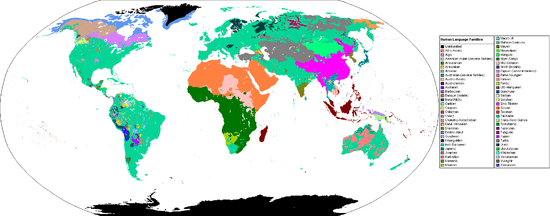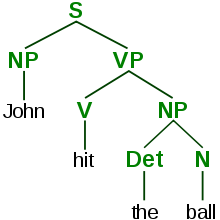
Projected on a world map are the principal language families of the world (and in some cases geographic groups of families).
For greater detail, see Distribution of languages in the world. Note that some families pictured here are controversial, and are not wholly agreed upon. Credit:
PiMaster3.
A language that can be shown to have evolved from the same ancestor as another language is in the same language family as the latter.
Linguistics
Def. "[t]he scientific study of language"[1] is called linguistics.
Languages
Def. "[a] form of communication using words either spoken or gestured with the hands and structured with grammar, often with a writing system"[2] is called a language.
Families
The web edition of the Ethnologue contains a list of language families:[3]
Theoretical language families
Def. a "group of languages believed to have descended from the same ancestral language"[4] is called a family.
Def. "[a] set of languages which have evolved from a common ancestor"[5] is called a language family.
Def. a "major language family which includes many of the native languages of Europe, Western Asia and India, with notable Indic, Iranian and European sub-branches"[6] is called an Indo-European language family.
Evolution
Def. "gradual directional change especially one leading to a more advanced or complex form"[7] is called evolution.
Research
Hypothesis:
- Going back 40,000 b2k may indicate some languages came from these earlier times.
Control groups

This is an image of a Lewis rat. Credit: Charles River Laboratories.
The findings demonstrate a statistically systematic change from the status quo or the control group.
“In the design of experiments, treatments [or special properties or characteristics] are applied to [or observed in] experimental units in the treatment group(s).[8] In comparative experiments, members of the complementary group, the control group, receive either no treatment or a standard treatment.[9]"[10]
Proof of concept
Def. a “short and/or incomplete realization of a certain method or idea to demonstrate its feasibility"[11] is called a proof of concept.
Def. evidence that demonstrates that a concept is possible is called proof of concept.
The proof-of-concept structure consists of
- background,
- procedures,
- findings, and
- interpretation.[12]
See also
References
- ↑ "linguistics, In: Wiktionary". San Francisco, California: Wikimedia Foundation, Inc. April 27, 2013. Retrieved 2013-06-08.
- ↑ "language, In: Wiktionary". San Francisco, California: Wikimedia Foundation, Inc. June 6, 2013. Retrieved 2013-06-08.
- ↑ M. Paul Lewis, Gary F. Simons, and Charles D. Fennig, ed. (2014). "Browse by Language Family, In: Ethnologue: Languages of the World, Seventeenth edition". 7500 West Camp Wisdom Road, Dallas, Texas 75236-5629 USA: SIL International Publications. Retrieved 2014-06-08.
- ↑ "family, In: Wiktionary". San Francisco, California: Wikimedia Foundation, Inc. 14 May 2014. Retrieved 2014-06-08.
- ↑ "language family, In: Wiktionary". San Francisco, California: Wikimedia Foundation, Inc. June 6, 2013. Retrieved 2013-06-11.
- ↑ "Indo-European, In: Wiktionary". San Francisco, California: Wikimedia Foundation, Inc. 26 May 2014. Retrieved 2014-06-08.
- ↑ "evolution, In: Wiktionary". San Francisco, California: Wikimedia Foundation, Inc. June 10, 2013. Retrieved 2013-06-11.
- ↑ Klaus Hinkelmann, Oscar Kempthorne (2008). Design and Analysis of Experiments, Volume I: Introduction to Experimental Design (2nd ed.). Wiley. ISBN 978-0-471-72756-9. http://books.google.com/?id=T3wWj2kVYZgC&printsec=frontcover.
- ↑ R. A. Bailey (2008). Design of comparative experiments. Cambridge University Press. ISBN 978-0-521-68357-9. http://www.cambridge.org/uk/catalogue/catalogue.asp?isbn=9780521683579.
- ↑ "Treatment and control groups, In: Wikipedia". San Francisco, California: Wikimedia Foundation, Inc. May 18, 2012. Retrieved 2012-05-31.
- ↑ "proof of concept, In: Wiktionary". San Francisco, California: Wikimedia Foundation, Inc. November 10, 2012. Retrieved 2013-01-13.
- ↑ Ginger Lehrman and Ian B Hogue, Sarah Palmer, Cheryl Jennings, Celsa A Spina, Ann Wiegand, Alan L Landay, Robert W Coombs, Douglas D Richman, John W Mellors, John M Coffin, Ronald J Bosch, David M Margolis (August 13, 2005). "Depletion of latent HIV-1 infection in vivo: a proof-of-concept study". Lancet 366 (9485): 549-55. doi:10.1016/S0140-6736(05)67098-5. http://www.ncbi.nlm.nih.gov/pmc/articles/PMC1894952/. Retrieved 2012-05-09.
External links
| Humanities resources |
|---|
| | Activities | | | | Articles | | | | Categories |
Agriculture ·
Anthropology ·
Archaeology ·
Art ·
Arts ·
Culture ·
Dominant group ·
Education ·
Genetics ·
History ·
Humanities ·
Language ·
Linguistics ·
Literature ·
Medicine ·
Philosophy ·
Psychology ·
Religious studies ·
Semantics ·
Social psychology
| | | Courses | | | | Fields | | | | Glossaries | | | | Lectures | | | | Lessons |
| | | Lists |
| | | Original research | | | | Portals |
History ·
Social sciences
| | | Problem sets | | | | Projects | | | | Proposals | | | | Quizzes | | | | Schools |
Agriculture ·
Alternative medicine ·
Anthropology ·
Archeology ·
Classics ·
Dentistry ·
Gastronomy ·
History ·
Life ·
Medicine ·
Pharmacy ·
Veterinary medicine
| | | Topics | |
|
| Linguistics resources |
|---|
| | Lectures | | | | Articles | | | | Courses | | | | Activities | | | | Lessons | | | | Problem sets |
| | | Quizzes | | | | Lists | | | | Projects | | | | Topics |
Computational linguistics ·
Computer programming ·
Foreign Language Learning
| | | Schools |
Computer science ·
Language and literature ·
Linguistics ·
Media Studies
| | | Fields | | | | Proposals | |
|
| Reasoning |
|---|
| | Lectures | | | | Articles | | | | Courses | | | | Topics | | | | Schools |
Biomathematics ·
Computer Science ·
Law ·
Linguistics ·
Mathematics ·
Philosophy ·
Psychology
| | | Activities |
| | | Lessons | | | | Quizzes |
Abstract concept generator/Quiz ·
Affirmation/Quiz ·
Answer/Quiz ·
Argumentation/Quiz ·
Assent/Quiz ·
Belief/Quiz ·
Canons/Quiz ·
Categorical Syllogism/Quiz ·
Certainty/Quiz ·
Comparison/Quiz ·
Computer Logic/Quiz ·
Conclusion/Quiz ·
Correctness/Quiz ·
Credulity/Quiz ·
Criteria/Quiz ·
Deduction/Quiz ·
Demonstration/Quiz ·
Discovery/Quiz ·
Discrimination/Quiz ·
Disillusionment/Quiz ·
Dissent/Quiz ·
Eccentricity/Quiz ·
Elementary logic/Quiz ·
Error/Quiz ·
Evidence/Quiz ·
Evolution/Quiz ·
Experiment/Quiz ·
Fact/Quiz ·
Foolishness/Quiz ·
Formalness/Quiz ·
Gamble/Quiz ·
Hypothesis/Quiz ·
Idea/Quiz ·
Ignorance/Quiz ·
Illusion/Quiz ·
Impossibility/Quiz ·
Improbability/Quiz ·
Incredulity/Quiz ·
Indiscrimination/Quiz ·
Induction/Quiz ·
Inference/Quiz ·
Insanity/Quiz ·
Intellect/Quiz ·
Intuition/Quiz ·
Judgment/Quiz ·
Knowledge/Quiz ·
Logic/Quiz ·
Mathematical proofing & reasoning/Quiz ·
Maxim/Quiz ·
Measurement/Quiz ·
Metalogic/Quiz ·
Metamathematics/Quiz ·
Misjudgment/Quiz ·
Negation/Quiz ·
Normative/Quiz ·
Overestimation/Quiz ·
Philosophical logic/Quiz ·
Philosophy/Quiz ·
Possibility/Quiz ·
Prejudgment/Quiz ·
Premise/Quiz ·
Primary mathematics:Boolean logic/Quiz ·
Principle/Quiz ·
Probability/Quiz ·
Proof/Quiz ·
Proposition/Quiz ·
Propositional logic/Quiz ·
Qualification/Quiz ·
Reasoning/Quiz ·
Sanity/Quiz ·
Semantics/Quiz ·
Solution/Quiz ·
Sophistry/Quiz ·
Theoretical astronomy/Quiz ·
Theoretical radiation astronomy/Quiz ·
Theory/Quiz ·
Theory of original research/Quiz ·
Thought/Quiz ·
Topic/Quiz ·
Truth/Quiz ·
Unbelief/Quiz ·
Uncertainty/Quiz ·
Underestimation/Quiz ·
Validity/Quiz
| | | Original research | | | | Proposal |
| | | History | | | | Projects |
| | | Glossaries | | | | Portals |
Portal:Computer Science ·
Portal:Mathematics
|
|
| Semantics resources |
|---|
| | Lectures | | | | Articles | | | | Courses | | | | Activities | | | | Lessons | | | | Problem sets |
| | | Quizzes | | | | Lists | | | | Projects | | | | Topics |
Computational linguistics ·
Computer programming ·
Foreign Language Learning
| | | Schools |
Computer science ·
Language and literature ·
Linguistics ·
Media Studies
| | | Fields | | | | Proposals | |
|
| Terminology resources |
|---|
| | Activities | | | | Articles | | | | Categories | | | | Courses | | | | History | | | | Lectures | | | | Lessons | | | | Lists | | | | Original research | | | | Projects | | | | Proposal | | | | Quizzes | | | | Schools |
School:Biology ·
School:Computer science ·
School:Language and Literature ·
School:Linguistics ·
School:Media Studies
| | | Texts | | | | Topics |
Topic:Computational linguistics ·
Topic:Computer programming ·
Topic:Foreign Language Learning
|
|
| Universal translator |
|---|
| | Articles | | | | Courses | | | | Definitions & Meaning | | | | Fields | | | | Lectures | | | | Lessons | | | | Projects | | | | Schools |
Computer science ·
Language and Literature ·
Linguistics ·
Media Studies
| | | Topics |
Computational linguistics ·
Computer programming ·
Foreign Language Learning
|
|
 This is a research project at http://en.wikiversity.org
This is a research project at http://en.wikiversity.org
 |
Development status: this resource is experimental in nature. |
 |
Educational level: this is a research resource. |
 |
Resource type: this resource is an article. |
 |
Resource type: this resource contains a lecture or lecture notes. |
 |
Subject classification: this is a geography resource . |
 |
Subject classification: this is a history resource . |
.jpg) |
Subject classification: this is a humanities resource. |
 |
Subject classification: this is a linguistics resource. |


![]() This is a research project at http://en.wikiversity.org
This is a research project at http://en.wikiversity.org